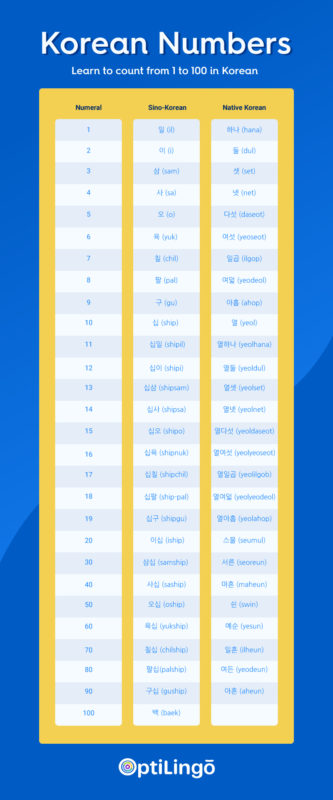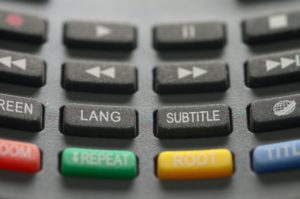Your Exclusive Guide on How to Count in Korean
Learning to count in Korean can be challenging for English speakers. That’s because the Korean number system uses two different number sets and a complex structure of grammar and logic. Both are essential for you to learn because each one has its purpose. These counting systems will probably seem a bit strange at first, but if you follow this guide, you’ll quickly master both Sino- and Native Korean numbers so you can start counting today! We’ll take you through both ways of counting, breaking it up to help make it easier for you to learn. Let’s get started.
Using Hangul for Korean Numbers
This guide on counting in Korean gives you the numbers in Hangul, the Korean alphabet. You’ll also see the number in the romanized form along with the Arabic numeral. If you don’t know Hangul, we suggest you take some time to review that first. It’ll help make learning how to count in Korean much, much easier. Plus, you can learn the Korean alphabet in about 30 minutes.
Count in Korean with Sino-Korean Numbers
The Sino-Korean number system was developed based on Chinese numbers. Sino-Korean is the term for Korean words that originated from the Chinese language. In fact, 60% of Korean vocabulary is Sino-Korean. You’ll use the Sino-Korean number system is for addresses, dates, money/currency, numbers greater than 100, and telephone numbers.
Number |
Sino-Korean Writing |
Sino-Korean Pronunciation |
1 |
일 |
(il) |
2 |
이 |
(i) |
3 |
삼 |
(sam) |
4 |
사 |
(sa) |
5 |
오 |
(o) |
6 |
육 |
(yuk) |
7 |
칠 |
(chil) |
8 |
팔 |
(pal) |
9 |
구 |
(gu) |
10 |
십 |
(ship) |
Count in Korean with Native (Pure) Numbers
Native Korean numbers are only between 1 (하나 ) and 99 (구십구). They are primarily used to identify the amount or quality of items. These names for Native Korean numbers are a bit more complex than the Sino-Korean ones. So, you should be prepared for that. Many of them also have 2 syllables. You should spend most of your time focusing on numbers 1 – 10. And even though Native Korean numbers go all the way up to 99, you’ll rarely use numbers over 10.
There are also combine these numbers with counter words you’ll need to learn (but we’ll talk about later).
Number |
Native Korean Number |
Native Korean Pronunciation |
1 |
하나 |
(ha-na) |
2 |
둘 |
(dul) |
3 |
셋 |
(set) |
4 |
넷 |
(net) |
5 |
다섯 |
(da-seot) |
6 |
여섯 |
(yeo-seot) |
7 |
일곱 |
(il-gop) |
8 |
여덟 |
(yeo-deol) |
9 |
아홉 |
(a-hop) |
10 |
열 |
(yeol) |
Why Does The Korean Number System Have Two Sets of Numbers?
Korean is a really old language. People argue that it’s unrelated to the Chinese language and culture. However, scholars trace the origin of Korean numbers back to Chinese numbers.
That’s why Korean has two sets of numbers that people use. These are Sino-Korean numbers and Pure or Native Korean numbers. And you’ll need to master both if you’re going to successfully learn how to count.
Here’s an easy infographic to help you remember both sets of Korean numbers! Keep it on hand for a quick reference:
Counter Words and Native Korean Numbers
Now, this is where counting in Korean gets a little complicated. When you’re counting nouns, you need to use specific counter words. These depend on what category or group the counter word is in. The construction of these goes like this:
noun + number + counter word
The counter word for most inanimate objects is 개 (ge). This is a common counter word that you’ll see often. However, there are a number of different counter words in Korean. You’ll want to familiarize yourself with these so you can quickly count all the things.
Keep in mind though, it’s not that much different in English. Sometimes, when you refer to certain items, like paper or water, you have to modify what you say to communicate more clearly. For instance, you as for a glass of water or 5 sheets of paper. In those instances, you need to add the word “sheet” and “glass” to better communicate the quantity of the item.
Common Counter Words Specific to Nouns
English noun |
Korean counter nouns |
Examples with Native Korean numbers |
People (general) |
명 (myeon) |
한 명, 두 명 |
People (respectful) |
분 (boon) |
한 분, 두 분 |
Animals |
마리 (mari) |
세 마리, 네 마리 |
Books |
권 (gwon) |
세 권, 네 권 |
Bottles |
병 (byung) |
다섯 병, 여섯 병 |
Glasses |
잔 (jan) |
다섯 잔, 여섯 잔 |
Age |
살 (sal) |
일곱 살, 여덟 살 |
Shoes & socks |
켤레 (kyulrae) |
일곱 켤레, 여덟 켤레 |
Examples of Korean Counters
- Three students – 학생 세 명 (student + three + counter for general people)
- Seven dogs – 개 일곱 마리 (dog + seven + counter for animals)
- One pair of socks – 양말 한 켤레 (sock + one + counter for socks)
Also, as you learn to count in Korean, the forms of number 1, 2, 3, 4, and 20 changes:
- 하나 → 한
- 둘 → 두
- 셋 → 세
- 넷 → 네
- 스물 → 스무
It’s not 하나 개, but 한 개, and it’s not 스물 명, but 스무 명.
Exceptions to Counter Words in Korean
You’ll use Sino-Korean and Native Korean numbers for different things. But there’s also a situation where you can use both systems. This happens when you’re counting months and telling time.
Examples of Counting Korean Months:
The counter words, in this case, are 개월 (gaewol) and 달 (dal). 개월 comes from Chinese characters, so you use Sino-Korean numbers there. 달 is a Native Korean word, therefore you use Native Korean numbers.
Examples of Telling Time in Korean
You’ll need both Sino-Korean and Native-Korean numbers when you’re telling time. It’s a bit tricky at first, but you’ll catch on quickly. You use Native Korean numbers in front of 시 (shi), meaning means “hour”. And you use Sino-Korean numbers in front of 분(bun), meaning means “minute”.
For a better understanding of how to tell the time in Korean, check out our guide!
Counting to 20 with Sino-Korean and Native Numbers
We all know that counting to 10 in any language is usually the easy part. It’s when you start getting into the bigger numbers that things can get a bit…weird. Don’t worry. Now that you know what Native Korean and Sino-Korean numbers look and sound like until 10, we’ll give you a few tricks you can use to rapidly learn how to count larger numbers.
It turns out that learning how to count to 20 in Korean is even simpler than in English:
11 is 10 + 1. 열 (yeol) is 10 and 하나 (hana) is 1 in Native Korean. In Korean, you simply put the two together. 11 in Native Korean is 열 하나 (yeolhana). 11 in Sino-Korean is 십일 (shipil).
12 is 10 + 2. So 12 in Native Korean is 열둘 (yeoldul). 12 in Sino-Korean is 십이 (shipi). And you continue this logic all the way to 19.
Sino-Korean and Native Numbers 11 – 19
Number |
Sino-Korean |
Native Korean |
11 |
십일 (shipil) |
열하나 (yeolhana) |
12 |
십이 (shipi) |
열둘 (yeoldul) |
13 |
십삼 (shipsam) |
열셋 (yeolset) |
14 |
십사 (shipsa) |
열넷 (yeolnet) |
15 |
십오 (shipo) |
열다섯 (yeoldaseot) |
16 |
십육 (shipnyuk) |
열여섯 (yeolyeoseot) |
17 |
십칠 (shipchil) |
열일곱 (yeolilgop) |
18 |
십팔 (ship-pal) |
열여덟 (yeolyeodeol) |
19 |
십구 (shipgu) |
열아홉 (yeolahop) |
As you can see, this counting logic is the same for Sino-Korean and Native Korean alike. And the pronunciation follows the logic too: you just put the two sounds together to form a new number. So far so good.
Counting Past 20 Using the Korean Number System
This is where the logic between Sino-Korean and Native Korean separates. Since 20 = 2 x 10, 20 in Sino-Korean is 이십 (eeship). 이 (i) is 2, and 십 (ship) is 10. You continue to build on the same vocabulary. Native Korean, on the other hand, came up with a separate word for 20, which is 스물 (seumul).
The logic to continue to 21 and onward is the same. 20 + 1 in Sino-Korean is 이십일 (eeshipil), and Native Korean is 스물하나 (seumulhana).
After that, the counting logic remains the same until 100. Tens will be a combination of a single numeral and 10 in Sino-Korean and completely new words in Native Korean.
Count By 10s with Native and Sino-Korean Numbers
Number |
Sino-Korean |
Native Korean |
20 |
이십 (eeship) |
스물 (seumul) |
30 |
삼십 (samship) |
서른 (seoreun) |
40 |
사십 (saship) |
마흔 (maheun) |
50 |
오십 (oship) |
쉰 (swin) |
60 |
육십 (yukship) |
예순 (yesun) |
70 |
칠십 (chilship) |
일흔 (ilheun) |
80 |
팔십 (palship) |
여든 (yeodeun) |
90 |
구십 (guship) |
아흔 (aheun) |
100 |
백 (baek) |
온 (on) |
Counting Larger Numbers
If you’re curious about how to say larger and larger numbers, then you’ll find everything you need here. Count from 100 all the way to 1 trillion. That should just about have you covered for counting all your won.
Number |
Sino-Korean |
Pronunciation |
Native Korean |
Pronunciation |
100 |
백 |
(baek) |
온 |
(on) |
200 |
이백 |
(ibaek) |
||
300 |
삼백 |
(sambaek) |
||
400 |
사백 |
(sabaek) |
||
500 |
오백 |
(obaek) |
||
600 |
육백 |
(yukbaek) |
||
700 |
칠백 |
(chilbaek) |
||
800 |
팔백 |
(palbaek) |
||
900 |
구백 |
(gubaek) |
||
1,000 |
천 |
(cheon) |
즈믄 |
(jeumeun) |
2,000 |
이천 |
(icheon) |
||
3,000 |
삼천 |
(samcheon) |
||
4,000 |
사천 |
(sacheon) |
||
5,000 |
오천 |
(ocheon) |
||
6,000 |
육천 |
(yukcheon) |
||
7,000 |
칠천 |
(chilcheon) |
||
8,000 |
팔천 |
(palcheon) |
||
9,000 |
구천 |
(gucheon) |
||
10,000 |
만 |
(man) |
드먼 |
(deumeon) |
10,000 |
만 |
(man) |
골 |
(gol) |
20,000 |
이만 |
(iman) |
||
30,000 |
삼만 |
(samman) |
||
40,000 |
사만 |
(saman) |
||
50,000 |
오만 |
(oman) |
||
60,000 |
육만 |
(yukman) |
||
70,000 |
칠만 |
(chilman) |
||
80,000 |
팔만 |
(palman) |
||
90,000 |
구만 |
(guman) |
||
100,000 |
십만 |
(sipman) |
||
1 million |
백만 |
(baekman) |
||
10 million |
천만 |
(cheonman) |
||
100 million |
억 |
(eok) |
잘 (jal) |
|
1 trillion |
조 |
(jo) |
울 (ul) |
Does the Korean Number System Use Zero?
There is no “zero” in Native Korean numbers. You only say it when counting in Sino-Korean. And there are 2 ways to say zero, depending on what you need to communicate. It’s also important to note that both ways come from Chinese. You need to use the right version in the right situation.
- 영 is Chinese for “zero” and used for counting
- 공 means “nothing”
When to Use “영” (Zero)
- When discussing the temperature (O degrees outside).
- When talking about Math or numbers with decimal points (0.00013)
- When describing points, like in a game, that you can get or lose. (The game was 7 – 1.)
- When referencing the time in a 24-hour clock (00:12 hrs).
When to Use “공” (Nothing)
- When talking about phone numbers (086-75309)
Master the Korean Number System FASTER!
As difficult as this counting system may seem to English native speakers, it’s not impossible to learn. Korean numbers are a great example of how unique and beautiful this language is. And you can learn it easily with OptiLingo.
OptiLingo offers scientifically proven language learning methods to get you to fluency fast. By using comprehensible input and spaced repetition, you can learn Korean effectively. And the stress-free environment of the app ensures that you can learn at your own pace. Have fun and master speaking a new language with OptiLingo!









